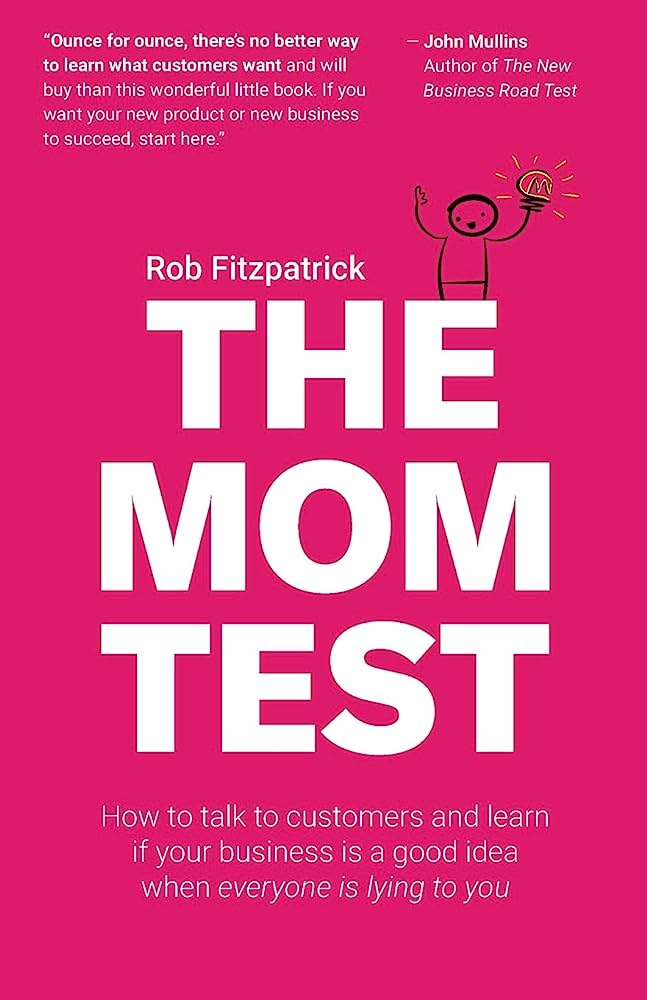The Mom Test: Unmasking Startup Success with Candid Insights from Your Toughest Critics
When you have a business idea, it’s crucial to determine its worth before investing your life savings into it. Seeking the opinions of your co-workers or family members might seem like a logical step, but unfortunately, they often provide only positive feedback to spare your feelings or avoid engaging with your pitch. So, how can you genuinely gauge the thoughts of your actual target audience?
Rob Fitzpatrick’s book, The Mom Test, presents a comprehensive guide on effectively posing questions that unveil authentic insights. By following the book’s advice, you’ll learn how to skillfully pitch your business idea while gaining invaluable feedback. It all begins with mastering the art of asking the right questions and prioritising commitment over mere compliments.
You can also read more about validating your startup here.
What is The Mom Test?

The Mom Test presents a framework for conducting idea validation conversations, or customer development interviews, in a manner that elicits honest responses instead of falsehoods. By employing this approach effectively, you can even conduct interviews with your own mother without falling victim to her desire to spare your feelings!
To successfully pass the Mom Test, it is essential to shift the focus of the conversation from your idea to the person’s life. Genuine idea validation involves understanding individuals, their experiences, and what motivates them. By delving into their personal stories, you gain valuable insights.
Rather than seeking generic or speculative opinions about the future, the Mom Test emphasises discussing specific instances from the past. The past offers more reliable information compared to people’s overly optimistic projections of their future actions, which often lead to misleading responses.
A key principle of the Mom Test is to minimise your own talking and maximise your listening. The more you dominate the conversation, the more you inadvertently bias the responses of the person you’re interviewing. By adopting a more attentive and receptive approach, you can uncover authentic insights without imposing your own biases.
The Mom Test Summary
When seeking feedback from your mother, it’s ineffective to directly ask whether she likes your idea for a new cookbook app. Instead, you should inquire about her device usage habits, when and how she utilises it, and her experiences with her current collection of cookbooks. By focusing on these “Mom Test” questions, you’ll gain valuable insights into her true preferences and desires, rather than receiving potentially biassed responses to your specific idea.
The essence of the Mom Test lies in understanding what the user genuinely wants, rather than attempting to impose your own idea upon them. By delving into their activities and interests, you can uncover their true needs and preferences. This approach involves actively listening to the user’s responses without misinterpreting or projecting your own assumptions onto their words. Ultimately, the Mom Test empowers you to genuinely understand and meet the user’s expectations, enhancing your chances of creating a successful product.
What Does The Mom Test Achieve?
Rob Fitzpatrick highlights the importance of early customer conversations in providing us with concrete information about our customers’ lives and perspectives. To steer these interviews towards factual insights rather than subjective opinions, Fitzpatrick introduces a straightforward test.
The first step is to focus the conversation on the customers’ life experiences rather than solely discussing your own idea. By exploring their personal journeys and challenges, you gain a deeper understanding of their needs and desires.
Next, Fitzpatrick recommends gathering specific information from the past rather than relying on broad generalisations about the future. People tend to be overly optimistic when envisioning their future behaviour, which can lead to misleading responses. By exploring their past actions and experiences, you obtain more reliable insights.
In addition, the test emphasises the importance of active listening and minimising your own talking. By allowing the customers to express themselves fully, you create a space for genuine insights to emerge. Remember, the goal is to obtain stronger insights than you would by asking simple questions like, “Do you like my idea?”
By following these straightforward steps, Fitzpatrick’s approach enhances the quality of early customer interviews, providing you with valuable facts and understanding about your customers’ lives and worldviews.
How Can I Apply The Mom Test To Product Research?

Your idea, which occupies your thoughts to such an extent that you begin to question the presence of a brain-eating parasite in your head, is akin to a paved path. However, the user’s true desire lies in the worn path—the one they actually want to follow. They couldn’t care less about your idea itself; what they truly seek is the ease of use and the most direct route to their desired outcome.
Approaching users with misguided questions can lead you to mistakenly believe that your own idea is brilliant. That’s why it is crucial to enter user interviews with a well-thought-out plan. Not only does this enable you to gather the most valuable user insights, but it also prevents you from becoming overly consumed with discussing your idea. Maintaining a focus on the user ensures that factual information naturally flows towards you like a magnet.
Occasionally, a customer may suggest a feature that appears to address one of their problems. Rather than accepting it at face value, Fitzpatrick advises delving deeper. By probing further into the customer’s needs and motivations, you can uncover the underlying essence of their request.
By keeping these principles in mind, you align your efforts with user needs, enabling you to gain meaningful insights and create a product that truly resonates with your target audience.
What Questions Should I Ask?
When a customer presents a request, it is essential to prompt them to provide precise explanations regarding how and why the proposed solution would benefit them. By delving into the underlying motivations, you can gain a deeper understanding of their needs. Consider asking questions such as:
- Why do you desire that specific feature or solution?
- How would incorporating it empower you to achieve your goals?
- How have you been managing without this feature thus far?
- How do you envision incorporating it into your daily routine?
- Should we prioritise adding this feature before the launch, or can it be included in a subsequent update?
These questions serve to elicit more detailed feedback from the user, which, in turn, generates richer and more powerful research data for your analysis. By encouraging customers to elaborate on their requests, you gain valuable insights into their specific needs, enabling you to better align your product or service with their expectations.
What Are The Most Important Things To Do In Market Research?

It is often unspoken but widely experienced that poorly executed user research can be more detrimental than conducting no research at all. This is particularly true due to the presence of confirmation bias, which reinforces erroneous beliefs. This risk becomes even more pronounced when the principles of the Mom Test are neglected.
That being said, it’s important to acknowledge that bias is inherent to some degree, and even a well-executed Mom Test cannot completely eliminate it. However, being aware of bias and actively working to mitigate its influence can significantly enhance the quality of your research. The Mom Test should serve as the fundamental basis for every interview you conduct. If you can extract valuable insights from your mom, you can do the same with anyone.
By applying the principles of the Mom Test, you lay the groundwork for effective research. While bias may persist to some extent, employing this approach and consciously limiting bias as much as possible will undoubtedly improve the validity and reliability of your findings. The Mom Test empowers you to gather meaningful insights from a diverse range of individuals, leading to more accurate and valuable research outcomes.
To learn more about market research, check out our guide to customer feedback loops and our tips to discovering the perfect target market for your new business.
Tips From The Mom Test
Compliments Are Worthless
Before soliciting feedback from potential customers, it is crucial to determine if they genuinely need your product or service, if they would be willing to purchase it, or if they have access to cheaper or even free alternatives. It is essential to prioritise the acquisition of real data and unfiltered truths rather than merely seeking compliments. However, how can you discern if someone is providing you with valuable information?
During your pitch, pay attention to whether the person’s feedback consists primarily of flattery. Excessive compliments often indicate a reluctance to commit. On the other hand, individuals who are genuinely interested in your idea will pose specific questions and seek detailed insights into various aspects of your business. Take inspiration from young or inexperienced entrepreneurs by eliminating idle chatter, excessive compliments, and overhyped aspects of your idea. Instead, focus on discussing the business itself.
By adopting a direct and business-oriented approach, you convey to investors that you are serious and focused. Simultaneously, family members and friends will understand that you value concrete advice rather than empty praise. Additionally, don’t hesitate to ask straightforward questions, such as their interest in investing or their willingness to commit in the long run. This helps determine if you and the other party are mutually aligned or if you would be wasting each other’s time.
By following these strategies, you can navigate through conversations with potential customers and stakeholders effectively, ensuring that you gather valuable feedback while minimising distractions and superficial responses.
Use Raw Data To Find Your Niche
In the pursuit of market data, many entrepreneurs overlook the true essence of their idea. While it can be difficult to admit that your business may be destined for failure, a wise executive knows when to pivot and when to persevere. The market holds a wealth of answers if you know where to seek them. However, it’s not just about asking the right questions; interpreting the responses is equally crucial.
Suppose you aspire to develop a fitness app. The vast expanse of the internet inundates users with an abundance of fitness and nutrition advice, making it daunting to navigate this realm. Therefore, it is essential to identify a specific niche and tailor your solutions accordingly. Attempting to target all groups simultaneously is impractical. Instead, focus on a specific gender, age group, occupation, or other defining characteristics. For instance, you could target stay-at-home moms in their twenties or thirties who seek efficient exercises to maintain their shape within limited time constraints.
Once you have identified your niche, it is time to engage with them through thoughtful questioning. However, if the market already offers comprehensive online solutions, developing a paid app that is likely to go unnoticed is unnecessary. Instead, seek out gaps where solutions are scarce but in high demand. Create products that offer significant utility and value to users, but be prepared to confront the harsh truth if your product does not meet a genuine need or lacks a specific niche. Often, the market itself holds the answers you seek, waiting to be discovered.
By embracing this approach, you can gain profound insights into the market landscape, enabling you to develop solutions that address real pain points and stand out amidst the competition. Remember to remain adaptable and receptive to market realities, as this will increase your chances of creating a successful and sought-after product or service.
Casual Meetings Are The Best

Formal meetings often receive more credit than they deserve from various perspectives. The process of setting them up requires significant time and meticulous planning, incurring additional costs compared to casual setups. Furthermore, there is no guarantee that a potential investor will accept your offer or even find your idea appealing. All the resources invested in formal meetings could easily go to waste. The solution? Opt for meetings in casual environments, such as coffee shops.
Not only does a relaxed setting put your interlocutor at ease, fostering a more open conversation, but it also saves time, money, and increases the likelihood of forming a genuine connexion, if not something more profound.
Furthermore, investors, like everyone else, dread tedious and unproductive meetings. We have all experienced our fair share of work-related gatherings that could have been effectively summarised through emails. Needless to say, investors are unlikely to look forward to the next one. Casual meetings have become the preferred choice for modern entrepreneurs seeking to gather information about their consumers. By creating a relaxed atmosphere, your interlocutor is more inclined to open up, revealing valuable insights for your business. Whether you are meeting with a focus group, potential customers, or individuals within your target niche, a casual setup can provide invaluable feedback. Moreover, if you are seeking to test market theories, meeting various people in a casual setting can prove highly beneficial.
By embracing casual environments for meetings, you can break away from the constraints of formal settings, fostering more genuine and fruitful conversations. This approach saves resources, facilitates a stronger connexion, and unlocks valuable insights for your entrepreneurial journey.
Learn more about what investors are looking for in your startup here.
FAQ
What Is The Mom Test About?
In The Mom Test, Rob Fitzpatrick explores techniques for determining whether your business idea is truly exceptional or dreadful. The book emphasises the importance of evaluating the opinions of your friends, family, and potential investors in an objective manner, rather than accepting their words solely to boost your confidence. Let’s delve into the process of assessing your business idea.
Why Is It Called The Mom Test?
By refraining from mentioning your idea, you will naturally begin to ask more insightful questions. This simple action holds immense value and can significantly enhance your customer conversations. It is commonly referred to as The Mom Test due to its ability to elicit questions that even your own mother cannot deceive you about. Embracing this approach represents the simplest yet most impactful way to improve your interactions with customers.
Overview
The Mom Test is an invaluable tool for startup validation. By seeking honest feedback from your toughest critics, such as your mom or close family members, you can uncover valuable insights and avoid building products that no one wants. Embrace the mindset of asking the right questions and listening objectively to their responses.
Remember, the goal is not to seek validation but to gain genuine feedback that can guide your product development and market strategy. The Mom Test empowers you to make informed decisions, iterate on your ideas, and increase your chances of startup success. So, don’t be afraid to put your ideas to the test and leverage the wisdom of your mom and other trusted critics to refine your startup journey.
Now that you’re equipped with the right questions to ask your target audience, check out our guides to closed customer feedback loops and how to validate your startup.







